Modern History: Excellent!
Westport (Google Maps location)
April 10, 2010
In 2019, the Westport Historical Society changed their name and the names of their museums to all fall under “Westport Museum For History & Culture.”
This may sound impossibly odd to anyone familiar with CTMQ reading this, but I don’t often go to museums for specific temporary exhibits. I just go to the museums and see what they’ve got going on at the time. However, Westport’s Historical Society museum at the Wheeler House was different. Not only because I went for a specific exhibit, but also because I was joined by my better two-thirds, Hoang and Damian.
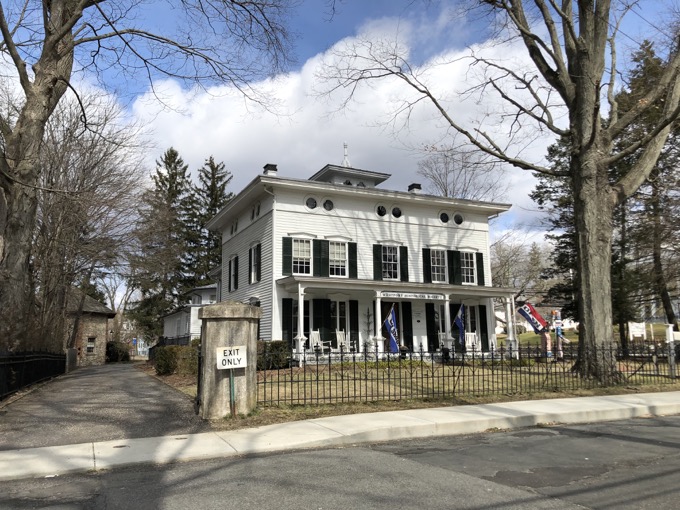
Those two rarely come with me to largish historical museums (Damian can be forgiven, and therefore so can Hoang, since someone needs to take care of the child), but this was a unique day. And it was wonderful; Butter up Damian at Silverman’s Animal Farm, slyly drive by Ida Tarbell’s house, a National History Landmark in Easton, slickly happen to pass Helen Keller’s house, then hit up the Westport Historical Society’s two museums, and finish the day with at “Best of” Ice Cream at Timothy’s in Bridgeport and finally enjoy a “best of” pizza at Modern Apizza in New Haven. Phew.
But what was the draw at the Wheeler House? An exhibition titled, Westport Modern: When Cool Was Hot. Yes, a historical society recognizing the historic significance of its rather impressive number of mid-century modern homes in town. Even before we arrived, I was hugely impressed with Westport for putting together an exhibit on something that many fuddy-duddy historians these days scoff at. (Of course, in a hundred more years, those scoffers will be scoffed at.)

We arrived at the museum and parked in the teeny tiny parking lot. Out back. As I mentioned, there are actually two museums here, both under the direction and ownership of the Society. The other one is the Museum of Westport History, housed in a unique octagonal “barn” behind the Wheeler House. We went to the house first.
I was pretty excited for this, because I knew Hoang would really enjoy the exhibit no matter what mood Damian was in. Fortunately, it appears we have a little mid-century enthusiast in our family. We were greeted by a very nice and smartly dressed woman who gave us the lay of the land and then left us on our own. Wonderful.
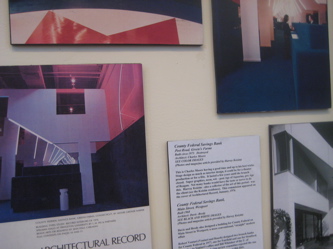
I was immediately struck with how… how nice this place was. It’s evident that most of these Gold Coast towns with money have well-kept historical society museums. At the time of my visit, Greenwich and Fairfield’s museums charged entrance fees and this place did not. They probably don’t need a dime, as their website (another well-above town-museum-average endeavor) notes their corporate sponsors, and the list is very impressive. (Banks, hedge funds, Newman’s Own, financial houses, etc.)
The money was reflected in the sharp literature we scooped up about the exhibit. The pamphlets were slick and professionally done. And the exhibit itself was top-notch; certainly superior to most temporary exhibits in historic house and/or town history museums. And not just because we were so enamored with the subject matter; no, Westport does it up right.
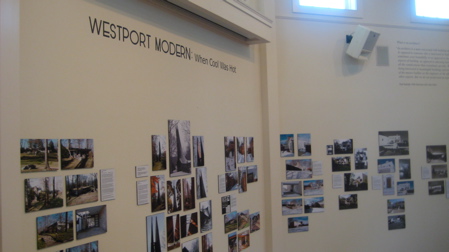
Anyone who is at least marginally interested or familiar with the mid-century modernist movement in American knows that southern Connecticut was a hotbed – if not thehotbed of the movement. The most famous enclave is in New Canaan where the Harvard Five left their indelible mark. Philip Johnson’s Glass House is also in New Canaan and is that rare beast: a modernist National Historic Landmark.
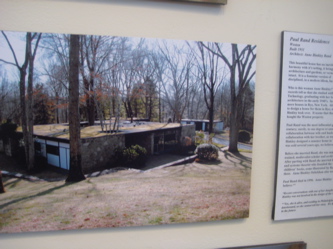
But what about Westport? Turns out, Westport has a rather extensive smattering of mid-century moderns too, and they feel it’s high time we start recognizing them. And so they did, with this exhibit at the Wheeler House. (I should note at this point that beyond the main gallery and what they call the Little Gallery at the Wheeler House, there is also the historical society’s permanent Victoriana collection and other things you’d more likely find at historic house museums. I’ll get to that stuff as well.)
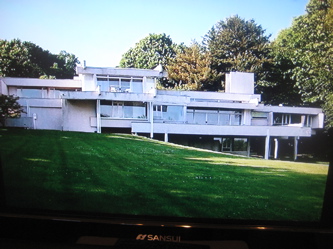
We entered the main gallery, called The Betty and Ralph Sheffer Hall, and were immediately struck by just how many modern houses were in Westport (and I suppose this exhibit included Weston too, since that town has no such museum). The beautiful photographic exhibit showcased over two dozen “important modern buildings” in the community.
There are buildings here by the likes of Mies van der Rohe, Richard Neutra, Paul Rudolph and and Victor Lundy but half the joy of the exhibit was discovering some of the heretofore unknown (to me) architects of the era.
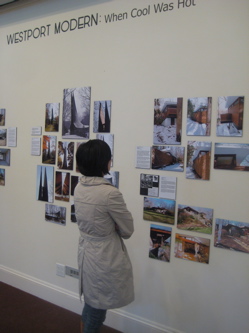
I quickly learned that this exhibit was sort of borne out of an effort to preserve. Back in 2007, Paul Rudolph’s Micheels House was demolished (I can only cringe at what’s in its place now) followed by the destruction of another modern home shortly thereafter. Both were, of course, destroyed so some some hedgefunder could build his oversized manse. Two guys got together and did a survey of the remaining modern buildings in Westport (and Weston), catalogued them and the exhibit was one way of presenting them. The survey turned up 24 houses, most previously unknown to authorities on modern architecture and notably, most were intact with few alterations.
Poking around, I think my favorite house is the Paul Rand house in Weston. First of all, you should know who Paul Rand is; perhaps the most iconic graphic designer of the last century. In rapidfire succession in 1960 Rand created the ABC, Westinghouse and UPS logos which are all still in use today. A prolific graphic designer. Anyway, his house was designed by a disciple of Mies van der Rohe, which is evident with its boxy shape and clean lines.
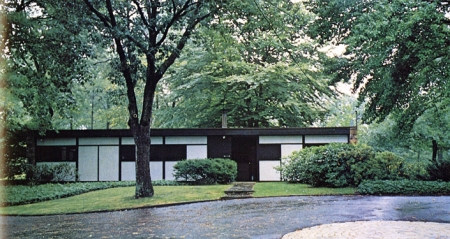
Paul Rand’s house
In addition to all the photos, there were a couple videos looping and even better, a little room set up featuring mid-century furniture. Other blogs about this exhibit that I’ve skimmed have snidely stated how they were “suddenly on the set of ‘Mad Men’,” and other supposedly witty comments. My wife has taught me many things in the ten years I’ve known her, and one of the best is the whole modernist architect/furniture relationship. She thrives on this stuff and has really opened my eyes to the pleasures of the good pieces. The little room set up here had a pretty good piece – an Eames LCW Dining Chair with metal legs. You’ll note that the photo below is Hoang’s attempt to look lustfully at the furnishings.
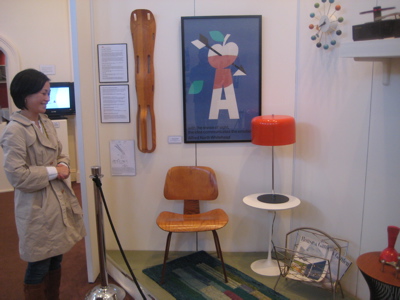
Problem was, Hoang never lusted after the LCW Dining chair. It was always the Eames LCW Lounge Chair – with wooden legs of course. But man, these “classic” pieces of furniture are not cheap for what you get. And so the LCW dream is deferred… Funny thing though, Damian was not shy about his enjoyment of the pieces as he climbed right up underneath the rope in an effort to check out the goods more closely. Great, now I’ve got two people wanting this stuff in our humble Cape.
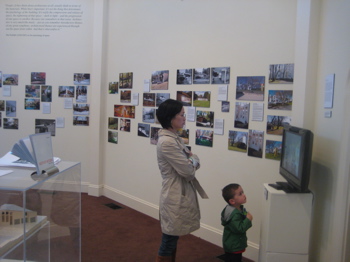
Moving over to what they call the Little Gallery, the exhibit was titled, Victor Civkin: Modern Genius Rediscovered.
This special exhibit reintroduces Victor Civkin, who, after escaping from Russia in the 1920s, settled here in our community. While employed by General Electric, he developed the “triangle plan” kitchen that is commonplace today. Civkin was also responsible for designing GE’s exhibit The World of Tomorrow at the New York 1939 World’s Fair as well as the design for a new kitchen at the FDR White House. Following World War II, he was the architect of the GE-sponsored Young American Homes; 74 of which were built across the country. After his retirement from GE, he opened his own architectural practice, completing over 900 private commissions. This is a not-to-be-missed American success story.
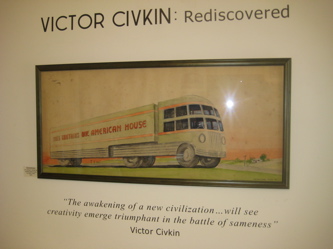
Well, we didn’t miss it. Civkin, whom we’d never heard of, was hugely prolific. After reading more about him while writing this page, his homes were also rather polarizing. The ones that still exist all look rather banal to me, but apparently some of them were pretty ugly in some people’s minds.

We moved over to the permanent part of the Wheeler House displays. I was hugely impressed with the modern exhibit – both in scope and just the mere fact they had it at a town historical society. I was also very impressed with Damian’s behavior and hoped it would continue as we poked around the large house. I shall now copy and paste descriptions of the house from the Westport Historical Society website:
The Wheeler House, built in 1795, was remodeled in the Italianate style in the 19th Century, and is listed on the National Register of Historic Places and the Connecticut Register of Historic Places. The house has three Victorian Period rooms and a gift shop. The only octagonal-roof, cobblestone barn in Connecticut, which is on the property, was completely restored over a ten-year period and houses the Museum of Westport History, displaying a diorama of the town as it looked toward the end of the 19th Century among other historical artifacts.
Research shows that Wheeler House started life as a simple house, possibly a saltbox, built by Captain Ebenezer Coley for his son Michael in 1795. Through the 19th century, the house had a succession of owners including Hezekiah Ripley, Ann Avery, Farmin Patchin, Morris Bradley and later, Julia Bradley Wheeler. Historically it has served its occupants as both a homestead and as a setting for business and mercantile interests.
I wish it was named the Farmin Patchin House.
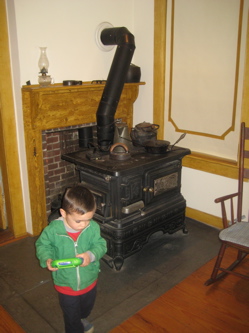
During the 1850’s and later in the 1860’s the house and grounds received extensive renovations, according to an account in the Westport Advisor of October 16, 1867. Morris Bradley, owner of the house in 1865, enlarged and converted the simple house to the popular mid-19th century Victorian Italianate villa style. It is characterized by the flat roof cupola, decorative brackets, “eyebrow” windows and gracious front veranda. The Bradley family, Morris and his wife Mary (Fanton), their two children Julia and Abram, moved to the Village of Westport from Weston, where he had been a blacksmith. The Bradley name was prominent in Weston as it was his father and brother who built the Edgetool Factory on Bradley Street, now Lyons Plains Road. By 1870, Morris had accumulated $90,000 worth of real estate, including three stores in the village. He listed himself as “Gentleman” in the census records. In the early 1870’s, Julia Bradley married Charles Wheeler of Stratford. He and his brother-in-law, Abram, ran the Bradley and Wheeler Grocery in s building which still stands in town.
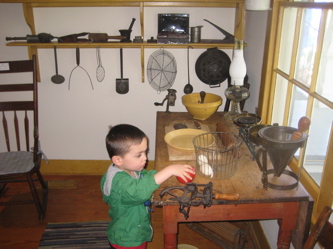
Funny thing, Weston has some hardcore town ordinances that disallow any sort of business development in town. To this day, that grocery store is pretty much the only business in Weston. In fact, this is a contributing reason as to why there is no Weston History museum because the town would view that as a business, believe it or not. So it’s nice of Westport to pick up a few crumbs here and there.
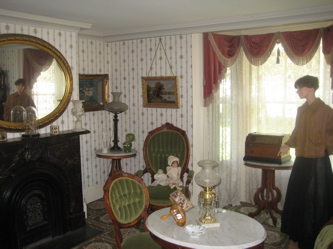
Both Morris and his son died in 1886, and the widowed Mary willed the family homestead to her daughter and son-in-law Julia and Charles Wheeler. Julia died in 1933, leaving the home to her two sons, William and Lewis. Dr. Lewis Wheeler had his office in the house and continued to occupy the house until his death in 1958. Dr. Wheeler willed the estate to its last individual owner, Charlotte Darby, his housekeeper. In accordance with her wishes, the landmark is known as Wheeler House in memory of Dr. Lewis H. Wheeler and his family, who had lived and worked in it for almost a century.
There are several rooms set up in a Victorian fashion. A kitchen/parlor, a bedroom, and a dining room.
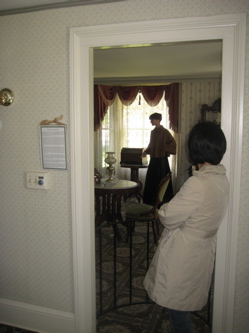
When Morris and Mary Bradley purchased and remodeled the house in 1865, America was in a period of great change. The Civil War had ended and all sectors of life were experiencing unprecedented growth: urban areas, transportation and industrial production. It was a time when the common man could see the possibility of increased wealth, comfort and education for himself and his family.
The Wheeler House parlor, kitchen and bedroom have been restored to reflect this period and the lives of an average family in the rapidly growing community of Westport. Documented by estate inventories of the Bradley family, census records, news articles and clues uncovered in the house, the resulting restorations show the Bradley family to have been typical of the gentility and respectability of the middle-class American in the Victorian era.
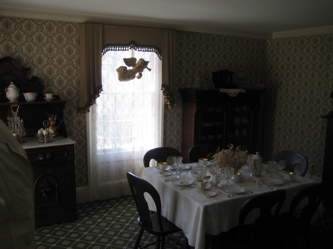
The Parlor was the showcase of the home, and was used only for special occasions. It contained the best furniture and decorative items owned by the family. The seven-piece black walnut parlor suite, the elaborate lady’s desk, the corner what-not and the panel curtains, ornamented at the top by elaborate fabric “lambrequins”, evidenced the good taste of the lady of the house. Even the lamps were ornate, as in the astral lamp displayed on the center table. Small statuary, mementoes, picture albums and curiosities were all displayed. No space was wasted in the Victorian Parlor.
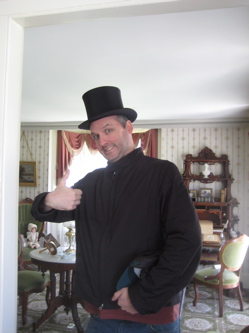
The Kitchen in a middle-class Victorian home was a room for working, and not used for family dining. During the restoration the original floor, when uncovered, indicated the location of the major kitchen furnishings. The cast-iron cook stove, dated 1870, was the most important item in the kitchen. The table was used as a workspace, and cooking utensils were stored on open shelves. New gadgets were flooding the market and were quickly embraced by the Victorian homemaker. Items such as the apple parer, pancake maker, coffee bean roaster, coffee grinder and lemon squeezer were guaranteed to shorten time spent in the kitchen. Decorative molds designed to enhance ice creams and puddings for the increasingly elaborate Victorian style of dining were eagerly sought.
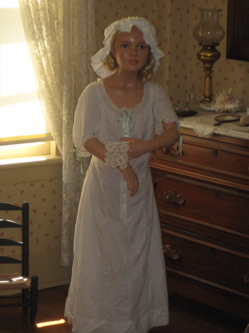
The museum itself had much more detailed descriptions of the rooms. I thought about transcribing them here, but really, that would be far too much. Since the website has nothing about the “Victorian Bedroom,” I’ll add a bit about that from their signage.
My favorite part is the bit stating that the bedroom visualizes the everyday life “of a family of average means such as the Bradleys.” Only in Westport is a giant Italianate Victorian cum museum reflective of an “average” family. (Okay, not “only” Westport but rather lower Fairfield County.)
The bedroom is the typical bedroom of these old houses, but this one is a bit more complete and focused on one period. The bed features a “Friendship Quilt” and all the other popular entertainments of the day, such as a brand new Edison phonograph. Here’s something I learned: There was no such things as closets back in the day.
Oh yeah, one more thing… remember that Eames LCW Lounge Chair Hoang loves so much? Well, happy birthday to my wife and son:
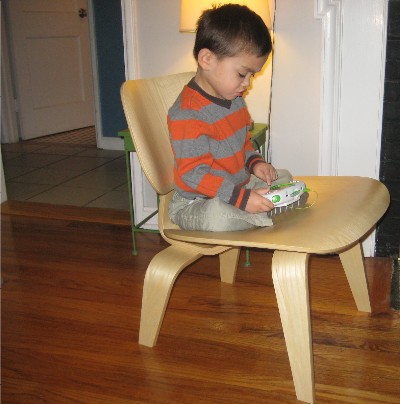
We had to ask the docent to unlock the Westport History Museum in the barn for us and upon doing so, we were unleashed into it all by ourselves. And boy, wait til you see Damian’s excitement about that! (CTMQ’s visit to the Wheeler Barn here)
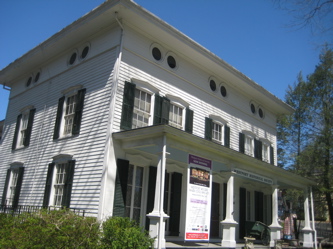
![]()
Westport Museum for History & Culture

Leave a Reply